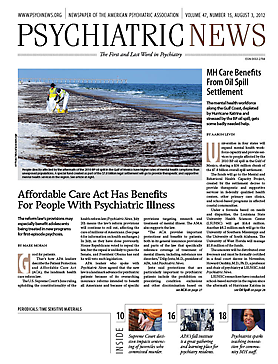Will health plans that carry a disproportionate number of people with costly chronic mental health problems be able to compete in the new “health exchanges” envisioned under the health care reform law?
Most will, according to a statistical analysis using simulation models to test two provisions—risk adjustment and reinsurance—that were written into the Affordable Care Act (ACA) to protect plans that carry a larger number of high-cost enrollees.
Risk adjustment is an ACA provision requiring that a federal or state exchange move funds from insurance plans with healthier enrollees to plans with sicker ones. Reinsurance is a provision in which all plans in a state contribute to a pool of money to reimburse costs to individual market plans for expenditures for any individual enrollee that exceed a high predetermined level.
The analysis, “Risk Adjustment in Health Insurance Exchanges for Individuals With Mental Illness,” found that those tools—risk adjustment and reinsurance—worked well to compensate health plans that attract a larger share of individuals with mental illness or other chronic illness. The analysis appeared July 1 in AJP in Advance.
That’s important because as millions of Americans become newly insured in health exchanges created by the ACA beginning in 2014, many will have chronic psychiatric illness. The long-term viability of plans covering those individuals will be a crucial test of the new system.
Is There Reason to Worry?
“The creation of state insurance exchanges under the ACA creates a whole new set of marketplaces for individuals and small groups to buy health insurance,” Colleen Barry, Ph.D., lead author of the analysis, told Psychiatric News. “About 15 million currently uninsured individuals will get coverage through state exchanges, and some of these newly enrolled individuals are expected to have mental health and substance use disorder treatment needs. We should be particularly worried about this population due to the threat of adverse selection in the exchanges. A lot of research suggests that while adverse selection is a problem for all health insurance, it is particularly problematic for individuals with mental illness, because their costs are higher on average, and these conditions tend to be chronic.”
Barry is an associate professor in the Department of Health Policy and Management at the Johns Hopkins Bloomberg School of Public Health.
Using 2006–2007 claims data from a sample of private and public health plans, Barry and colleagues compared expected health plan compensation under diagnosis-based risk adjustment with actual health care expenditures under different assumptions for chronic mental health and other medical conditions. Analyses were conducted with and without the addition of $100,000 reinsurance.
Health plan cohorts were created by simulating enrollment for 100 health plans, each with 50,000 random members. The researchers reassigned a predetermined number of individuals from the sample of “real” private and public plans into simulated plans based on the presence of chronic mental health conditions to create four plan risk levels with 25 plans in each: low, moderately low, moderately high, and high morbidity. They used an analogous process to create four plan cohorts by share of enrollees with a chronic physical illness.
Both Tools Prove Mostly Effective
In general they found that both risk adjustment and reinsurance work well to compensate health plans that attract a larger share of individuals with mental illness. At the far extremes of the range, however, there were plans whose simulated cohorts resulted in both overpayment and underpayment—the latter to a degree that may be cause for concern as it may lead plans to “cherry pick” healthy enrollees or even actively discourage enrollment of patients with mental illness.
For health plans in the high-morbidity cohort with the largest share of enrollees with chronic mental health conditions, risk adjustment would result in average underpayment of less than 1 percent. However, the worst reimbursed plan in the high-morbidity group would be underpaid by 3.5 percent.
(Interestingly, plans with a large cohort of people with chronic physical health conditions had larger underpayment both on average and at the extreme than plans with high numbers of patients with chronic psychiatric conditions.)
Barry told Psychiatric News that state health exchanges have options to address the problems associated with plans at the extreme end of underpayment. “One option would be to handle selection in state exchanges in the same manner as most private employers do—by selective contracting with a limited number of health plans and actively managing the contracts to monitor quality,” she said.
Overall, the analysis is good news for patients with chronic mental illness enrolling in new health exchange plans. “We find that both risk adjustment and reinsurance play an important role in better compensating health plans that attract a larger share of individuals with mental illness, and this is critical to reducing the incentive for health plans to cherrypick the healthiest enrollees and discourage those with mental illness from joining,” said Barry.

